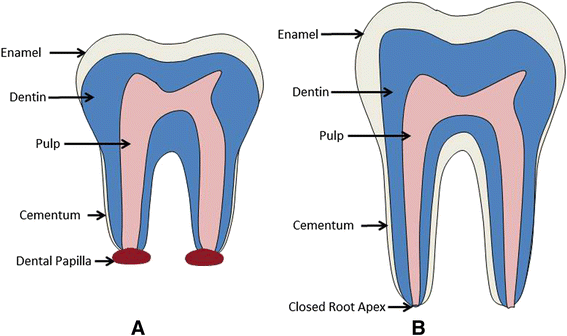Biomimetic microenvironments for regenerative endodontics
- PMID: 27257508
- PMCID: PMC4890532
- DOI: 10.1186/s40824-016-0061-7
Biomimetic microenvironments for regenerative endodontics
Abstract
Regenerative endodontics has been proposed to replace damaged and underdeveloped tooth structures with normal pulp-dentin tissue by providing a natural extracellular matrix (ECM) mimicking environment; stem cells, signaling molecules, and scaffolds. In addition, clinical success of the regenerative endodontic treatments can be evidenced by absence of signs and symptoms; no bony pathology, a disinfected pulp, and the maturation of root dentin in length and thickness. In spite of the various approaches of regenerative endodontics, there are several major challenges that remain to be improved: a) the endodontic root canal is a strong harbor of the endodontic bacterial biofilm and the fundamental etiologic factors of recurrent endodontic diseases, (b) tooth discolorations are caused by antibiotics and filling materials, (c) cervical root fractures are caused by endodontic medicaments, (d) pulp tissue is not vascularized nor innervated, and (e) the dentin matrix is not developed with adequate root thickness and length. Generally, current clinical protocols and recent studies have shown a limited success of the pulp-dentin tissue regeneration. Throughout the various approaches, the construction of biomimetic microenvironments of pulp-dentin tissue is a key concept of the tissue engineering based regenerative endodontics. The biomimetic microenvironments are composed of a synthetic nano-scaled polymeric fiber structure that mimics native pulp ECM and functions as a scaffold of the pulp-dentin tissue complex. They will provide a framework of the pulp ECM, can deliver selective bioactive molecules, and may recruit pluripotent stem cells from the vicinity of the pulp apex. The polymeric nanofibers are produced by methods of self-assembly, electrospinning, and phase separation. In order to be applied to biomedical use, the polymeric nanofibers require biocompatibility, stability, and biodegradability. Therefore, this review focuses on the development and application of the biomimetic microenvironments of pulp-dentin tissue among the current regenerative endodontics.
Keywords: Biomimetic microenvironments; Extracellular matrix; Pulp-dentin tissue; Regenerative endodontics; Revascularization; Tissue engineering.
Figures




References
Publication types
Grants and funding
LinkOut - more resources
Full Text Sources
Other Literature Sources
Miscellaneous

